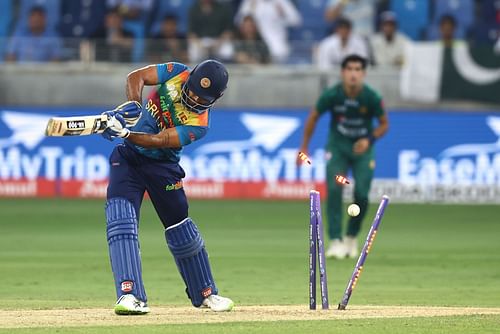
Pakistan cricket team's pace battery could rule the T20I world
The Pakistan cricket team has had a rich culture of fast-bowling over the years. Wasim Akram and Waqar Younis’ name obviously springs to mind but there have also been several others who have taken international cricket by storm. The combination of pace and movement, which is not very ubiquitous, is one of the primary reasons why the Pakistan cricket team has been able to hold its own on the world stage.
The story was not too dissimilar at this year’s Asia Cup. From Pakistan’s perspective, they might look at it as some kind of failure, considering they were thoroughly outplayed in the game that mattered. That said, there were numerous positives that accrued to the Pakistan cricket team. One of those was the way their fast bowlers bowled throughout the tournament, often blowing away whoever stood at the other end.
On Sunday against Sri Lanka, that came to fruition, albeit only partly. Naseem Shah, who might not have been a part of the squad had Mohammad Wasim Jnr and Shaheen Shah Afridi been fit, got the ball to talk in the first over itself. Kusal Mendis, prior to the Islanders’ Super Four clash against the Pakistan cricket team, had been setting the tone at the top of the order for his side. In two games against Pakistan, though, he lasted all of two deliveries, with his off stump flying becoming one of the defining images of the final.
There was not a lot of respite for Sri Lanka. Once they had seen off Naseem, Haris Rauf came hurtling in. Haris, for those unaware, is slightly quicker than Naseem, although it could be argued that the latter is more adept at extracting movement.
On Sunday, Haris portrayed a side of the game many thought he didn’t have. In the fifth over, he got the ball to curve into Danushka Gunathilaka very late. The Sri Lankan had a waft at it and was beaten all ends up, with his stumps being left in an almighty mess.
This delivery, by the way, was bowled at more than 150 km/hr. In between, Haris also accounted for Pathum Nissanka. So, Pakistan had picked up three wickets in the powerplay, with each of those deliveries bowled at more than 140 km/hr.

Pakistan cricket team's pacers were exceptional in the Asia Cup
Wicket-taking in the powerplay was a feature throughout the tournament for the Pakistan cricket team. They ended up picking 13 wickets during the field restrictions, by far the most any team had managed at the competition. And, they were missing Shaheen, who many would argue is the best new-ball operator in T20I cricket. Scary depth, eh?
Throughout the Asia Cup, no team bowled as many balls above 140 km/hr than Pakistan either. They almost bowled four times as many deliveries in that speed bracket as Sri Lanka, who were the next on this list. And apart from the final, when Bhanuka Rajapaksa tore them to shreds, they were pretty good. That Pakistan resorted to variations and conceded a truckload of runs is both ironic and fitting of how they should just keep bowling as quick as they can.
Fast-bowling has long been a virtue for Pakistan. Even when T20I cricket began, they relied on their pace bowling battery to win them games. Umar Gul was a genuine match-winner in the shortest format. Sohail Tanvir’s unorthodox bowling action was a perfect fit for T20I cricket, and Mohammad Amir, despite getting embroiled himself in many a controversy, was penetrative whenever he bowled.
In an era where batters have begun dominating a lot more, though, the Pakistan cricket team’s fast bowlers have a chance to act as the decisive tilting scale in close contests. It very nearly happened against Sri Lanka on Sunday too, only for Rajapaksa and Wanindu Hasaranga to use their experience and wrestle control of the game.
The current generation of pacers have are built to have as many deliveries as possible in their arsenal. It is not at all a bad method to follow. The more change-ups you have, the more you can keep the batters guessing. But when you have raw pace, like most of the Pakistan cricket team’s fast bowlers do, it might make sense for them to just let their hair down, and intimidate batters with sheer pace.
Better equipment and a fearless mindset means that batters are not as uncomfortable against sheer pace as they once were. What pace does, though, is it forces batters to make decisions that split second quicker, and that, especially in clutch games, could make all the difference.
The next T20 World Cup is slated to be held in Australia, where conditions will suit those who bend their back. And Pakistan, luckily, have many bowlers cut out of that very cloth. At this Asia Cup, they have seen that their brand of seriously quick fast bowling can get the job done, and that their band of pacers can rule the T20I world.
Apart from the obvious cricketing gains, it also sets pulses racing. It makes people watching that tad bit happier, and it makes the team believe that they can come back from any situation because, well, pace is pace, yaar. There is simply no substitute for it.
It is fast bowling in its purest form. It might sound stupid but it is actually fast bowling. Not many teams in the world have as much depth as the Pakistan cricket team, and only a handful can probably say they have such raw, unfiltered pace.
The Pakistan cricket team, thus, might want to place all their eggs in this basket. It might prove detrimental from time to time, especially if batters start getting a hang of the speed at which they are bowling. Yet, it also seems their best possible approach moving into a tournament they have not won since 2009.
